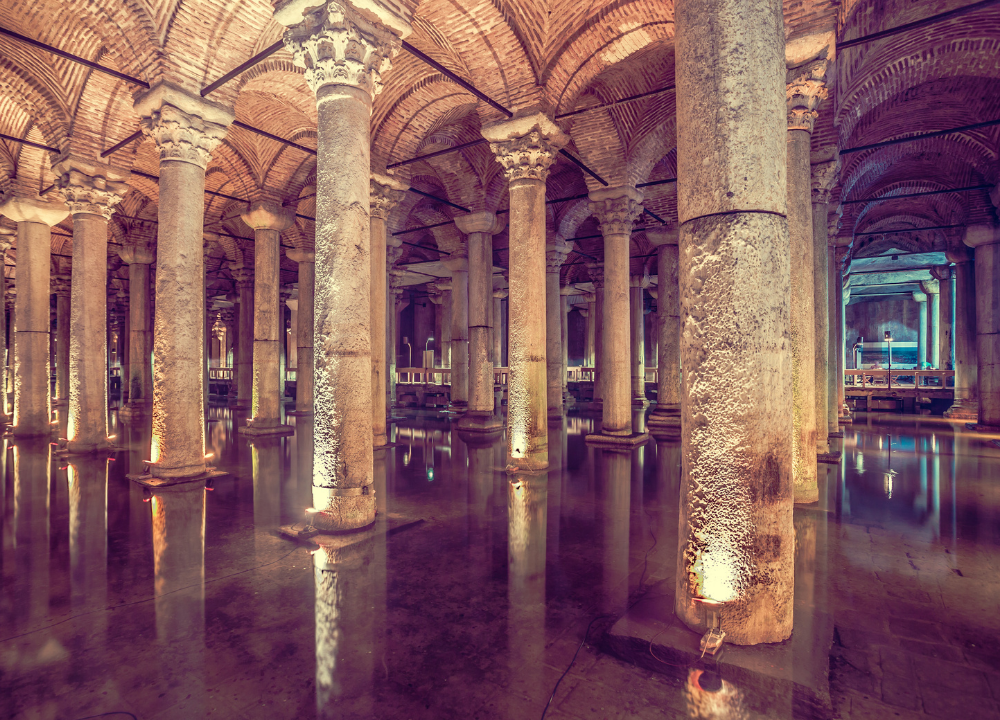Basilica Cistern History, Importance and Features

Located in the historical peninsula of Istanbul, the Basilica Cistern was built by the Byzantine Emperor Justinian I in the 6th century. This impressive structure is of great importance both historically and architecturally.
Basilica Cistern is one of the most valuable structures of Istanbul with its history, importance and features. This cistern offers visitors a unique experience and is a must-see for those who want to explore the historical texture of Istanbul. By visiting the Basilica Cistern, you can see the marvels of Byzantine water engineering and enjoy the mystical atmosphere.
May be interested in: Topkapi Palace: Istanbul's Historical and Cultural Heritage
History of the Basilica Cistern
The Basilica Cistern was built by the Byzantine Emperor Justinian I in 532 to meet the water needs of Istanbul. Considered one of the most important water reservoirs of the Byzantine Empire, this cistern was built as part of the reconstruction process after the Nika Uprising, which affected a large part of the city in the 6th century.
The cistern was designed to store water, which was vital for Byzantine palaces and other large structures. Covering an area of approximately 9,800 square meters and with a storage capacity of 100,000 tons of water, the Basilica Cistern is one of Istanbul's most important achievements in the field of water engineering.
In the construction of the cistern, especially for the columns, materials collected from ancient buildings were reused. Some of these columns belong to the Roman period and were brought from different regions. The 336 columns, each 9 meters high, made the cistern architecturally impressive.
During the Byzantine period, the water of the Basilica Cistern was supplied by water channels brought from the Belgrade Forests. The cistern, which was also used during the Ottoman period, continued to meet the water needs of Topkapı Palace and the surrounding buildings. However, over time, the cistern lost its use with the change of waterways and the introduction of more modern water systems.
The Basilica Cistern was popularly called “Basilica Palace” for a while during the Ottoman period. This name derives from the impressive view created by the columns inside the cistern. In the 16th century, the Ottoman traveler Evliya Çelebi visited the cistern and mentioned this fascinating structure in his travelogues.
The Importance of the Basilica Cistern
The Basilica Cistern is considered one of the historical and engineering wonders of Istanbul. Built during the Byzantine Empire to meet the city's water needs, this cistern is 140 meters long and 70 meters wide. This wide and deep structure has a storage capacity of approximately 100,000 tons of water, making it one of the largest water reservoirs of the period. The cistern played a critical role in Istanbul's water supply and was of strategic importance during both the Byzantine and Ottoman periods.
The 336 columns inside the cistern present an architecturally and aesthetically fascinating sight. These columns were collected from different ancient structures and reused during the construction of the cistern. The columns, each 9 meters high, create the appearance of a forest in the cistern's interior. Each of these columns has different designs and was made with materials brought from different places. The drops of water falling on the floor of the cistern and the reflection of the columns offer a mystical atmosphere to the visitors, which makes the cistern a fascinating and attractive place.
The most remarkable elements inside the cistern are the columns with Medusa heads. These heads belong to the ancient Roman period and constitute the most mysterious and intriguing parts of the cistern. Although it is not known exactly how and why the Medusa heads were used here, the mythological stories and legends of the Medusa heads on these columns attract the attention of visitors. The fact that one of the Medusa heads is placed upside down and the other sideways increases the mystical and symbolic meaning of these heads and reinforces the mystical atmosphere of the cistern.
The Basilica Cistern is more than just a water reservoir, it is an important structure reflecting the rich history and cultural heritage of Istanbul. It provides information about the water engineering and architecture of the Byzantine and Ottoman periods, and today it hosts various cultural events and exhibitions. The cistern is an indispensable point of visit for tourists in the historical peninsula of Istanbul, along with other important historical buildings such as Hagia Sophia and the Blue Mosque. The mystical atmosphere and historical significance of the cistern make it not only a tourist attraction, but also a time capsule that carries the traces of the past into the present.
Features of Basilica Cistern
The Basilica Cistern is fascinating with its architectural features and the atmosphere created by the water inside. The drops of water falling on the floor of the cistern offer visitors a mystical experience. The walking paths inside the cistern allow visitors to explore every corner of the cistern. In addition, various cultural events and exhibitions organized in the cistern also increase its importance.
One of the most remarkable features of the cistern is the Medusa heads on its columns. These heads have been the subject of mythological stories and are of great interest to visitors. How and why the Medusa heads were used in the cistern is still a mystery.
Visit to the Basilica Cistern
The Basilica Cistern is located in the historical peninsula of Istanbul, very close to Sultanahmet Square. The cistern is open to visitors all year round and is one of the most popular tourist attractions in Istanbul. While visiting the cistern, you can also see other historical buildings such as Hagia Sophia and the Blue Mosque.
The Basilica Cistern is an important structure that reflects the rich history and cultural heritage of Istanbul. This cistern is a center of attraction for both local and foreign tourists. Visiting the cistern offers the opportunity to witness the history and architecture of Istanbul up close.


